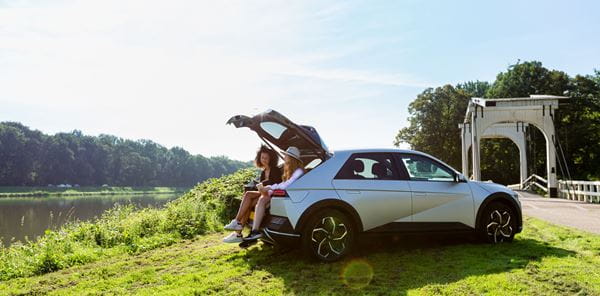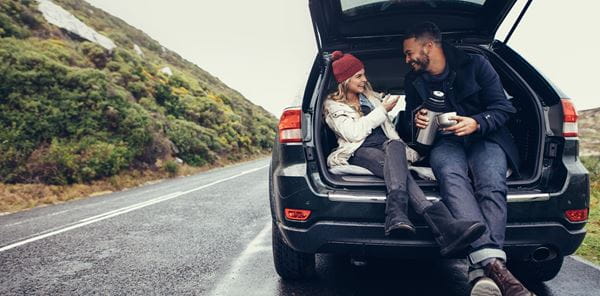
From ticket to charging station: the history of refueling
Refueling a car seems natural to everyone today, but the way we do this has changed enormously over the past 50 years. Where we used to have to stand at the pump to fill up our car with petrol, we can now plug it in at home. And technology is not standing still, because the way you charge your electric car will also evolve in the future.
The first fuel card in our country was introduced in the early 1980s. However, LeasePlan had already set foot in Belgium in 1972. Back then, the driver of a lease car did not have a handy card to fill up at petrol stations. People had to pay for the fuel and then bring the receipt to work to get their expenses reimbursed. Sometimes, companies worked with an invoicing system. The staff at the filling station would write down the amount of fuel that had been consumed and send a monthly invoice to the employer of the driver.
The fuel card as a game changer
The arrival of the fuel card changed everything. Suddenly refueling happened almost automatically and you could often use the card to fill up abroad as well. Today, many fuel cards still work abroad, although the driver depends on the employer’s car policy. LeasePlan’s current fuel card is valid at about 90% of Belgian filling stations. Practical, isn’t it? And when you lose your fuel card, you can pay with your bank card and request a refund afterwards.
Electric driving: a journey of discovery
LeasePlan is a pioneer when it comes to electric mobility. But as a pioneer you often have to explore undiscovered territory. So, when we decided to fully invest in electric mobility, we took a leap into the deep end. To find out what challenges we could expect, we gave a LeasePlan employee the opportunity to drive an electric car for two years.
Maya Tasevski, Order & Delivery Officer at LeasePlan, was asked to test drive a Nissan Leaf in 2012. “I found it very interesting because at that moment nobody was driving electric”, Maya looks back. “It was so exciting to discover what electric driving was all about. And I was sold immediately. Today, I still drive electric, and I think it’s a fantastic experience.”
Personal experience as a basis for the EV service
During her test period, Maya wrote down her findings in a blog. “Little was known about electric cars, so I had to try everything out. Can you take an EV to a carwash? What happens to your range in winter? What is the best way to charge the car? Those were all questions we had at the time. Of course, the range was the biggest concern, because in 2012 it was not as extensive as today.”
At LeasePlan, we used Maya’s experiences to finetune our EV service. It helped us expose missing links in processes and adjust our operations and communication. Thanks to her extensive testing, we were able to estimate the costs of electric driving and decide whether we as a leasing company were ready to switch to EVs.
Following Maya, the managing director and several LeasePlan executives also switched to electric cars. They acted as ambassadors within the company. Around 2017, the company decided to start the electric transition. Today, almost everyone at LeasePlan drives an electric car. And to this day, we use the information from our own employees to keep improving our service.
A single charging card for plug-in hybrid and EV
Electric cars gained momentum in 2020. This was partly due to the wider range of electric models on offer, and partly the result of new tax rules. LeasePlan was therefore also looking for solutions to make charging more efficient. Initially, drivers of a plug-in hybrid received a charging card in addition to their traditional fuel card. Now, drivers of both plug-in hybrids and full EVs have a single card for charging and refueling. Trading in your EV for a traditional car to go on holiday? Then you can continue refueling with the same card.
Legislation not yet adapted to charging infrastructure
The charging infrastructure also continues to evolve. For example, many lease drivers now have a wallbox at home. Unfortunately, legislation is lagging behind and thereby creating a lot of challenges.
By installing a wallbox at the home of lease drivers, we suddenly enter the private environment of our customers. On top of that, there is no legislation that stipulates what happens to this wallbox when a person moves to a different employer. Until recently, the wallbox used to be removed but then customers were left with damage to their homes. Therefore, customers now get the chance to purchase the wallbox.
Charging is becoming more practical
In 2009, LeasePlan installed the first charging station in Belgium at its office. Today, our office in Diegem has 37 charging stations. Moreover, these stations are constantly evolving. Drivers can now charge their car with a smart charging cable at a conventional socket. But we are also working on ultra-intelligent cables that allow you to rapidly charge your car from an industrial power outlet, making the wallbox superfluous.
Electric charging will go faster and faster
Currently one third of the lease cars ordered at LeasePlan are 100% EV. And the supply of charging solutions also continues to grow. Although we do not expect an increase in the capacity of car batteries, manufacturers are looking for better and faster ways to charge, which will ultimately make the range less important.
For example, they are investigating methods to develop charging stations where you can fully recharge your car in two to five minutes. EV drivers will no longer notice any difference with conventional refueling. Companies are also investing in charging stations where 50 to 100 cars can be charged at the same time and can even be discharged in case of energy shortage. This allows companies to offer electricity when there is not enough power available on the grid.
An Asian company is currently designing a system where EV drivers enter a garage and robots replace their battery while they remain in the car. They then drive off with a fully charged battery, while the other one is charged for the next driver.
We clearly are only at the beginning of electric mobility today. At LeasePlan we have been innovating for 50 years, but the next 50 years of mobility will be at least as exciting.







